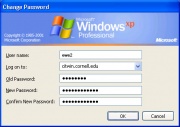Corporate Security and IT Policies
From Computing and Software Wiki
| Line 22: | Line 22: | ||
Software security refers to the protection of digital media; it includes hardware necessary to implement software security, such as a computer running the corporate firewall. | Software security refers to the protection of digital media; it includes hardware necessary to implement software security, such as a computer running the corporate firewall. | ||
[[Image:Passwordchange.jpg|thumb|A user password policy change window shown in Windows XP[X]]] | [[Image:Passwordchange.jpg|thumb|A user password policy change window shown in Windows XP[X]]] | ||
| + | |||
| + | From a software perspective, corporations protect local data with encryption and backup, intruders from outside the organization with firewalls, as well as internal threats | ||
==Social Employee Security== | ==Social Employee Security== | ||
Revision as of 00:40, 13 April 2009
Corporations need to protect their physical and soft assets in today’s world of thieves and hackers. To do so, they implement IT and Security Policies, which protect their corporations against such attacks. These prevention mechanisms can be split up into three main categories: physical, software, and social (employees).
Contents |
Physical Security
Miniature mirrors are sometimes used on monitors to allow workers using a screen to see what’s behind them. The main purpose of these mirrors is to allow the user to view unwanted eyes from behind viewing confident information on the subject screen.
Security Cards are a common security feature, typically used on all entrances to secured buildings. Usually a public lobby-area with a receptionist is open for visitors, however, access to the remaining parts of the building are secured with a security system which requires authorized employees to swipe security passes to gain access.
Other self-explanatory physical security features include:
- Locks
- Cabinet Locks
- Badge Access
- Security Cameras
- Shredders
- Mirrors on monitors
Shredding machines are also frequently located in offices to prevent dumpster diving. Sometimes, a service is used from a company that performs shredding services for a fee.
Software Security
Software security refers to the protection of digital media; it includes hardware necessary to implement software security, such as a computer running the corporate firewall.
From a software perspective, corporations protect local data with encryption and backup, intruders from outside the organization with firewalls, as well as internal threats
Social Employee Security
Although smaller companies sometimes omit discussion social engineering within their security practices, it is strikingly one of the most important areas to cover. Essentially, this type of security mechanism aims to prevent social engineering.
Companies typically have a statement in their security policy manual such as [X]:
Don't reveal a password to the boss
Don't talk about a password in front of others
Don't hint at the format of a password (e.g., "my family name")
Don't reveal a password over the phone to ANYONE
Don't reveal a password to co-workers while on vacation
If someone demands a password, refer them to this document or have them call someone in the Information Security Department.
IT Administrators typically do not have direct access to view account passwords. Instead, passwords are typically encrypted, and should a user forget his or her password, the administrator must reset the password, rather than being able to view the user’s former password and give it out.
People Security – IT Desk taught against social networking, never give out passwords over phone, only email (which is secured with password)
Other Security measures
People Security – IT Desk taught against social networking, never give out passwords over phone, only email (which is secured with password)
Password Standard (#characters, variety of characters, password chaged every 2 months) Secure communications (128 triple A or something, blackberry encrypted)
References
Some companies have statements of security as shown here: http://www.total.com/static/en/medias/topic1608/pol-sur-001_security_policy12.pdf
picture: http://www.rsscctv.com/images/P/200x200_tkc215_300%2520WEB.jpg
password change policy: http://support.netmail.sg/images/changepwd_owa2.gif
password Policy: http://www.sans.org/resources/policies/Password_Policy.pdf
http://en.wikipedia.org/wiki/Physical_Security
password change pic: http://www2.cit.cornell.edu/services/systems_support/images/changepassword2.jpg


